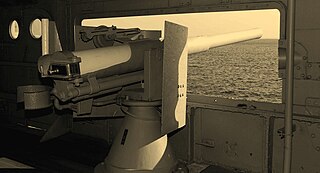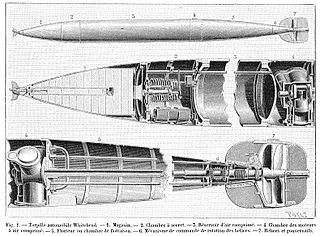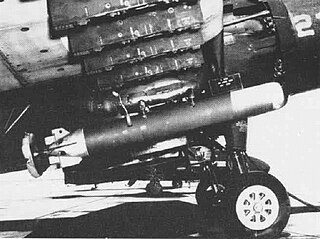
A depth charge is an anti-submarine warfare (ASW) weapon designed to destroy submarines by detonating in the water near the target and subjecting it to a destructive hydraulic shock. Most depth charges use high explosives with a fuze set to detonate the charge, typically at a specific depth from the surface. Depth charges can be dropped by ships, patrol aircraft and helicopters.

The Type 93 was a 610 mm (24 in)-diameter torpedo of the Imperial Japanese Navy (IJN), launched from surface ships. It is commonly referred to as the Long Lance by most modern English-language naval historians, a nickname given to it after the war by Samuel Eliot Morison, the chief historian of the U.S. Navy, who spent much of the war in the Pacific Theater. In Japanese references, the term Sanso gyorai is also used, in reference to its propulsion system. It was the most advanced naval torpedo in the world at the time.

USS Bluefish (SSN-675), a Sturgeon-class attack submarine, was the second ship of the United States Navy to be named for the bluefish.

The Type 91 was an aerial torpedo of the Imperial Japanese Navy. It was in service from 1931 to 1945. It was used in naval battles in World War II and was specially developed for attacks on ships in shallow harbours.

The Type 95 torpedo was a torpedo used by submarines of the Imperial Japanese Navy during World War II.

The Sting Ray is a British acoustic homing lightweight torpedo (LWT) manufactured by GEC-Marconi, who were later bought out by BAE Systems. It entered service in 1983.

The Mark 44 torpedo is a now-obsolete air-launched and ship-launched lightweight torpedo manufactured in the United States, and under licence in Canada, France, Italy, Japan and the United Kingdom, with 10,500 being produced for U.S. service. It was superseded by the Mark 46 torpedo, beginning in the late 1960s. The Royal Australian Navy, however, continued to use it alongside its successor for a number of years, because the Mark 44 was thought to have superior performance in certain shallow-water conditions.

The Mark 45 anti-submarine torpedo, a.k.a. ASTOR, was a submarine-launched wire-guided nuclear torpedo designed by the United States Navy for use against high-speed, deep-diving, enemy submarines. This was one of several weapons recommended for implementation by Project Nobska, a 1956 summer study on submarine warfare. The 19-inch (480 mm)-diameter torpedo was fitted with a W34 nuclear warhead. The need to maintain direct control over the warhead meant that a wire connection had to be maintained between the torpedo and submarine until detonation. Wire guidance systems were piggybacked onto this cable, and the torpedo had no homing capability. The design was completed in 1960, and 600 torpedoes were built between 1963 and 1976, when ASTOR was replaced by the Mark 48 torpedo.

The W58 was an American thermonuclear warhead used on the Polaris A-3 submarine-launched ballistic missile. Three W58 warheads were fitted as multiple warheads on each Polaris A-3 missile.
The B61 Family is a series of nuclear weapons based on the B61 nuclear bomb.

The Mark 37 torpedo is a torpedo with electrical propulsion, developed for the US Navy after World War II. It entered service with the US Navy in the early 1950s, with over 3,300 produced. It was phased out of service with the US Navy during the 1970s, and the stockpiles were sold to foreign navies.

The QF 12-pounder 12-cwt gun (Quick-Firing) was a common, versatile 3-inch (76.2 mm) calibre naval gun introduced in 1894 and used until the middle of the 20th century. It was produced by Armstrong Whitworth, Elswick and used on Royal Navy warships, exported to allied countries, and used for land service. In British service "12-pounder" was the rounded value of the projectile weight, and "12 cwt (hundredweight)" was the weight of the barrel and breech, to differentiate it from other "12-pounder" guns.

The Whitehead torpedo was the first self-propelled or "locomotive" torpedo ever developed. It was perfected in 1866 by British engineer Robert Whitehead from a rough design conceived by Giovanni Luppis of the Austro-Hungarian Navy in Fiume. It was driven by a three-cylinder compressed-air engine invented, designed, and made by Peter Brotherhood. Many naval services procured the Whitehead torpedo during the 1870s, including the US Navy. This early torpedo proved itself in combat during the Russo-Turkish War when, on 16 January 1878, the Ottoman ship Intibah was sunk by Russian torpedo boats carrying Whiteheads, though this story has been disputed in one book.

The 10" Mark 43 torpedo was the first and smallest of the United States Navy light-weight anti-submarine torpedoes. This electrically propelled 10-inch (25-cm) torpedo was 92 inches long and weighed 265 pounds (120 kg). Described as "a submersible guided missile", the torpedo was designed for air or surface launch. The Mod 0 configuration was designed for launch from helicopters or fixed-wing aircraft, and the Mod 1 configuration was for helicopters only. Both were electrically driven and deep-diving, but had relatively short range. They were classified as obsolete in the 1960s.
The Mark 35 torpedo was the first of the United States Navy deep-diving anti-submarine torpedoes designed for surface launch. This electrically propelled 21-inch (53-cm) torpedo was 162 inches long, weighed 1770 lb (803 kg), and carried a 270 lb (122.5 kg) Torpex high explosive warhead. This torpedo used one of the earliest active guidance systems and was introduced in 1949, and was classified as obsolete in the 1960s.
The Mark 27 torpedo was the first of the United States Navy 19-inch (48-cm) submarine-launched torpedoes. This electrically-propelled torpedo was 125 inches long and weighed 1174 pounds (534 kg). The torpedo employed a passive acoustic guidance system and was intended for both submarine and surface targets. Nicknamed "Cutie" by submarine crews, the Mark 27 entered service in 1943 as a defensive weapon. The torpedo was classified as obsolete in the 1960s.
There have been a number of 21-inch (53.3cm) torpedoes in service with the Royal Navy of the United Kingdom.

The 3.5-inch Forward Firing Aircraft Rocket, or 3.5-Inch FFAR, was an American rocket developed during World War II to allow aircraft to attack enemy submarines at range. The rocket proved an operational success, and spawned several improved versions for use against surface and land targets.

This is a list of Active Royal Navy weapon systems.
A nuclear torpedo is a torpedo armed with a nuclear warhead. The idea behind the nuclear warheads in a torpedo was to create a much bigger explosive blast. Later analysis suggested that smaller, more accurate, and faster torpedoes were more efficient and effective.















